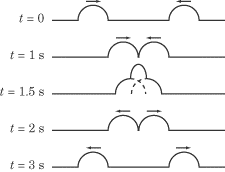Lesson: Chapter - 17
Superposition
Suppose that two experimenters, holding opposite ends of a stretched string,
each shake their end of the string, sending wave crests toward each other. What
will happen in the middle of the string, where the two waves meet?
Mathematically, you can calculate the displacement in the center by simply
adding up the displacements from each of the two waves. This is called the
principle of superposition: two or more waves in the same place are
superimposed upon one another, meaning that they are all added together. Because
of superposition, the two experimenters can each send traveling waves down the
string, and each wave will arrive at the opposite end of the string undistorted
by the other. The principle of superposition tells us that waves cannot affect
one another: one wave cannot alter the direction, frequency, wavelength, or
amplitude of another wave.
Destructive Interference
Suppose one of the experimenters yanks the string downward, while the other
pulls up by exactly the same amount. In this case, the total displacement when
the pulses meet will be zero: this is called destructive interference.
Don’t be fooled by the name, though: neither wave is destroyed by this
interference. After they pass by one another, they will continue just as they
did before they met.

Constructive Interference
On the other hand, if both experimenters send upward pulses down the string, the
total displacement when they meet will be a pulse that’s twice as big. This is
called constructive interference.

Beats
You may have noticed the phenomenon of interference when hearing two musical
notes of slightly different pitch played simultaneously. You will hear a sort of
“wa-wa-wa” sound, which results from repeated cycles of constructive
interference, followed by destructive interference between the two waves. Each
“wa” sound is called a beat, and the number of beats per second is given
by the difference in frequency between the two interfering sound waves:


Example
Modern orchestras generally tune their instruments so that the note “A” sounds
at 440 Hz. If one violinist is slightly out of tune, so that his “A” sounds at
438 Hz, what will be the time between the beats perceived by someone sitting in
the audience?
The frequency of the beats is given by the difference in frequency between the
out-of-tune violinist and the rest of the orchestra:
 Thus, there will be two beats per second, and the period for each beat will be
T = 1/f = 0.5
s.
Thus, there will be two beats per second, and the period for each beat will be
T = 1/f = 0.5
s.
Back
Next
Next to display next topic in the chapter.
Practice Questions
Video Lessons and 10 Fully Explained Grand Tests
Large number of solved practice MCQ with explanations. Video Lessons and 10 Fully explained Grand/Full Tests.